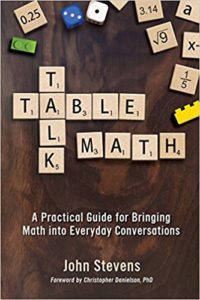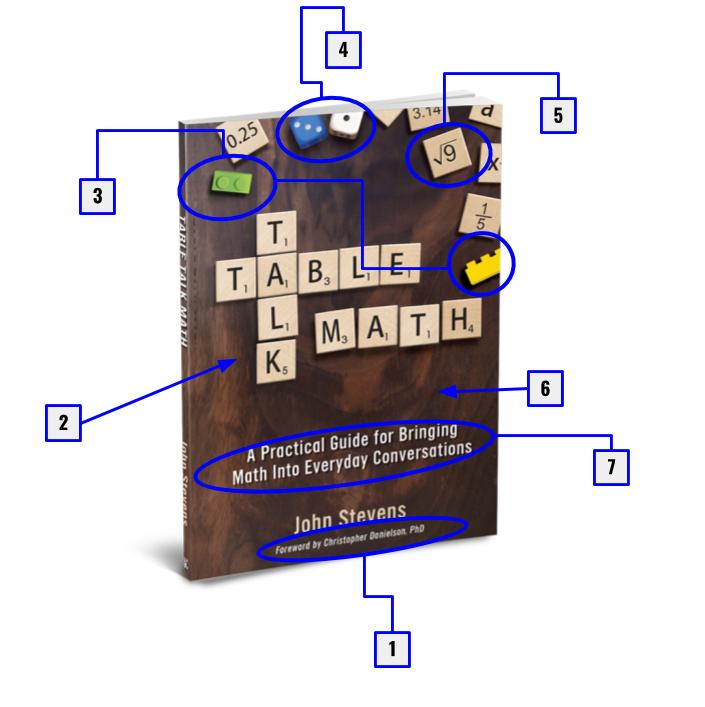This guest post from Table Talk Math author, John Stevens, is the single GREATEST description of a book cover in the history of the world! Hyperbole? I don’t think so!
We are PUMPED to simultaneously release his book with the AMAZING Teaching Math with Google Apps: 50 Gsuite Activities by Alice Keeler and Diana Herrington. It is filled with POWERFUL pedagogy…not just tools. How good is it? The foreword was written by Mathematical Mindsets author, Jo Boaler. Ummm…wow! Check out the #GoogleMath hashtag on Twitter.
Without any further delay…here is John with his incredible description of exactly why you should judge his book by the cover!
Take it away…
1. The Foreword
Putting words on a printed page is a tough thing to do. Finding the right thing to say and being willing to back it up has made me nervous in all three books I have written, but this one is different. Table Talk Math is a solo project filled with vignettes from friends and colleagues and I had no idea what to expect.
When I reached out to Christopher Danielson, author of Which One Doesn’t Belong, the chances were pretty slim in my head. I’m not as confident as I may lead on, and the chance of him being willing to jump into the project seemed like a long shot. When he immediately said yes, I was floored. Christopher Danielson just agreed to write the foreword for my book! People don’t do that out of sympathy or take it lightly, and I am beyond honored to have his contribution be the first thing that people will read.
2. The Design of the Title
The premise of Table Talk Math is that you–the parent or guardian–can host rich and meaningful conversations at the dinner table, coffee table, or anywhere you and your family congregate.
The design of the title was intentional and important. For one, Table Talk and Math are separated. If you aren’t talking with your child, start. Please. This is the most important thing that you could ever do for him or her. Learning from your child, playing with your child, and being there for your child is the most precious gift you can ever provide, and no book or website will ever change that. This isn’t only true for their younger years; in fact, as they get older, your children will need you even more. Be there.
Another key piece of the title was the design with Scrabble tiles. As I mention in the book, we didn’t grow up with much, so games were the easiest way for us to find entertainment. We played Scrabble as a family to learn vocabulary, to count points… Nah, we played to be a family, and we loved it.
3. The Lego Pieces
My kids have reinvigorated a reason to pull out the bucket of Legos and build. Fatherhood has a ton of ups and downs, and one of the biggest ups has been folding in the things that I was so passionate about as a child. Seeing my boys’ creativity go from a pile of bricks to a house, a dinosaur, and a boat-car-dragon in the matter of minutes must be why my Gram and Papa always loved to just sit back and watch us boys play.
Patterns and conversations don’t have to be hard, and Lego bricks provide an equalizer. In the book, Fawn Nguyen shares about patterns and I just love how natural it can all be. Plus, the colors of the bricks on the cover are green and gold, representing the Green Bay Packers. Yep, Go Pack Go.
4. The Dice
Nowadays, when my family gets together, we love to play a game called Farkle. Before then, it was Yahtzee. In between then, there were a number of other dice-based games that we grew up playing. Seeing a pair of dice on the cover was an important one. Yes, I’m from Nevada and the game of Craps is a prominent staple of The Silver State. No, that wasn’t the inspiration.
The numbers and colors are also important. The blue and white represent my favorite baseball team, the Los Angeles Dodgers. Yes, Giants fans, I know it’s been a long time since they brought home a World Series, yet I still love a franchise that does so much to promote diversity, deliver on equity, and provide opportunities for a guy who would one day become a Hall of Famer.
Number 31, Mike Piazza, was selected in the 62nd round of the 1988 Major League Baseball draft as a favor to his father from Tommy Lasorda. When he made his debut in 1993, I was ten years old and looking for an athletic hero to believe in. To think that he worked as hard as he did, made as much of an impact as he did, and left such a legacy on his profession after being selected as a favor… I had to tip my hat to Mike Piazza and this was the best way I could draw it up. Because of him, I grew up knowing–and witnessing–that it was possible to chase a dream.
5. The Square Root of 9
When I joined my first soccer team, I was handed number 9. At the time, as I mention in the book, I was watching Los Angeles Kings hockey games on a regular basis and I loved watching Bernie Nichols play alongside Wayne Gretzky and Tim Watters. He, too, was number 9, and something about that made me proud. Ever since then, all the way through high school, my jerseys had 9 on them.
My Twitter handle has a 9. My email has a 9. I’m borderline OCD about the number 9.
In 2008, my best friend, Preston, passed away. It was devastating for me and for our entire framily (y’know, friends as family) group, and I’ve been finding subtle ways to pay homage to a great man throughout my own life path ever since. Preston’s number was 3, and everyone knew that.
So, in this case, the square root of 9 is 3, and the root of who I am has been made better by Preston, number 3. Cheers, buddy.
6. The Wooden Background
If you’ve been following the blog for a while, you know that I dabble in the woodworking projects on the side. Recently, I have tried my hand at the fine craft of cutting boards, serving trays, and carved spoons. They take patience, but they are stunning when completed right.
The background of Table Talk Math is actually an image my dad took of a serving tray that I made. There’s no stain, no photoshop saturation, nothing. Just a pure image of a pure product. Truth be told, I hope that’s what Table Talk Math reads like as well. I didn’t want any fluff, no distractions, and no false hope. There’s nothing quite like looking at a freshly-crafted project and enjoying the result.
7. The Subtitle
Practicality is key here. There are a lot of books available that will walk you through the forest of ideas to try out with students, with colleagues, and copious research is available on why those are helpful. In Table Talk Math, I really wanted the feeling of “I can totally try this out” and the subtitle speaks to that.
I also wanted the reader to feel like they could try something out with their child on a daily basis. We don’t need to have a “math day” in order to bring math into the conversation. Also, we don’t need to force it. We can find something in the everyday hustle and bustle to talk about, so long as we keep talking with–not at–our children.
Now is your chance. You’ve judged the cover, so check out the book, available on Amazon TODAY!
Also, I have created a free weekly newsletter to share ideas and prompts with parents, so be sure to head over and sign up!
Thank you to Christopher Danielson, Andrew Stadel, Fawn Nguyen, Mary Bourassa, Nat Banting, and Annie Fetter for offering up your thoughts and expertise that is in the book. You are all truly inspirational and I couldn’t be more grateful for you saying YES.
Thank you to Dave and Shelley Burgess for another opportunity to share my voice, however loud it may become.









